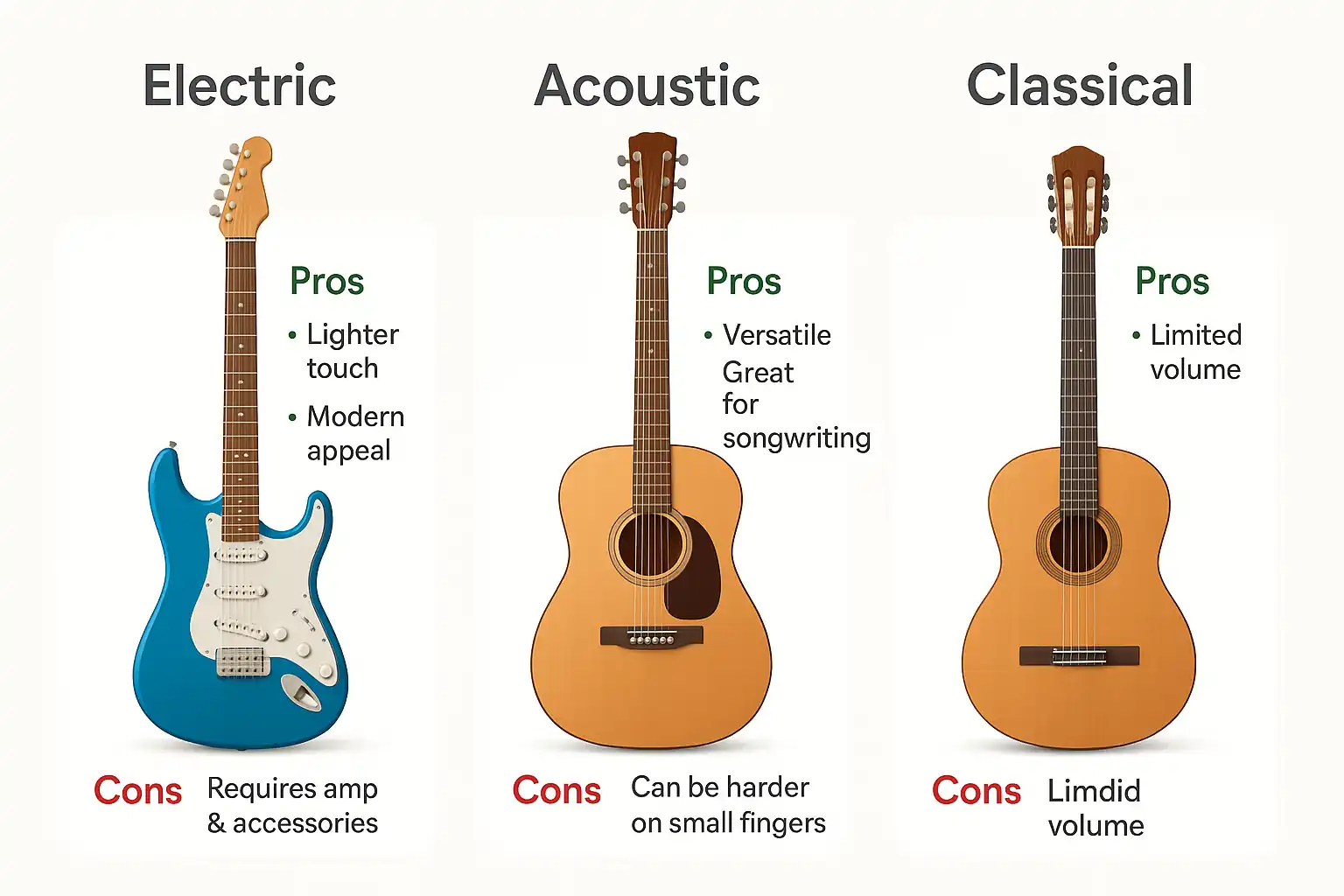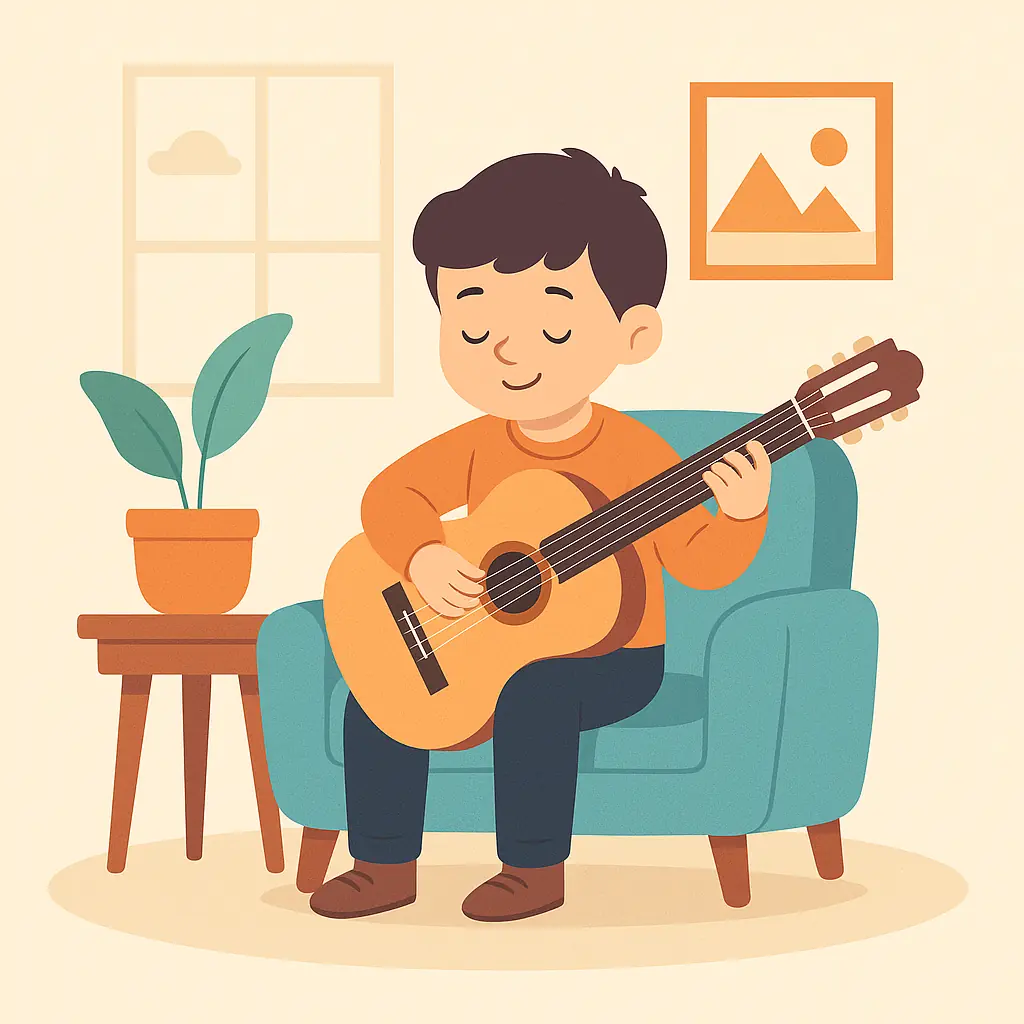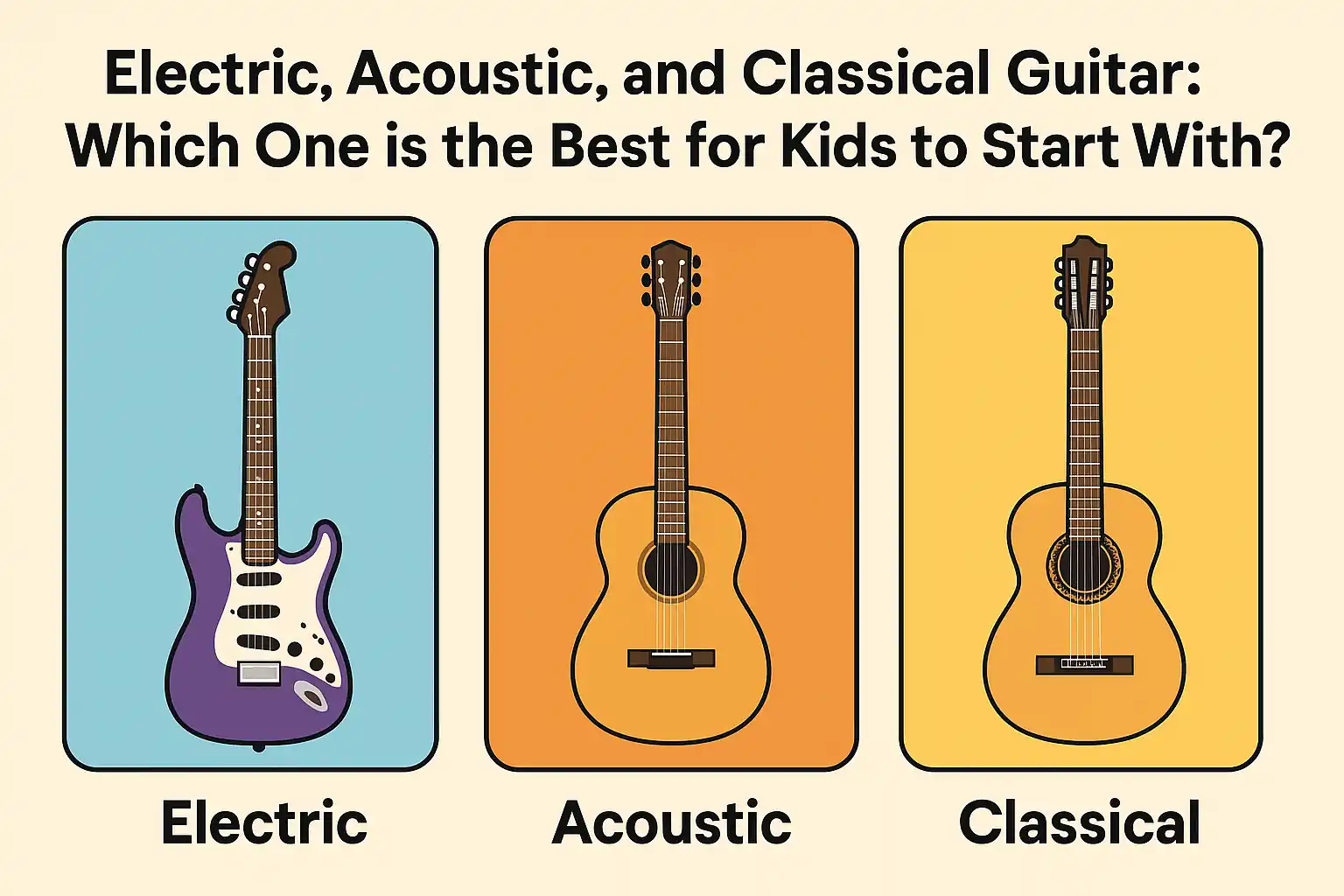Why the Right Guitar Choice Shapes a Child’s Music Journey
The guitar you choose for your child can be the difference between a lifelong passion and a short-lived interest. Many parents assume “a guitar is a guitar,” but in reality, comfort, size, and playability often determine whether a child sticks with lessons or quits after a few frustrating weeks.
Take Mia’s story: She was a bright, enthusiastic 7-year-old who dreamed of playing her favorite songs. Her parents surprised her with a full-size dreadnought acoustic guitar. While it looked beautiful, it was far too large for her small frame. The neck felt heavy, the strings were tough on her fingers, and within two months, her practice sessions became rare and reluctant. Eventually, she stopped playing altogether.
This is why choosing the right guitar type and size isn’t just a gear decision — it’s a motivation decision. The wrong choice can create unnecessary physical discomfort and mental resistance, while the right choice can make practice sessions something your child looks forward to every day.
Why This Decision Matters
- Comfort = Motivation: If the guitar fits, they’ll play more often and for longer sessions.
- Playability: Shorter necks, lighter strings, and proper scaling reduce strain on small hands.
- Sound Satisfaction: Even beginners feel more inspired when their instrument sounds good.
If you want your child to start strong, combine the right guitar choice with structured learning. Online guitar lessons for kids offer flexibility and fun while keeping young players engaged and progressing steadily.
Understanding Electric, Acoustic, and Classical Guitars

Before you decide which guitar is best for your child, it’s essential to understand the unique qualities of electric, acoustic, and classical guitars. Each one offers a different feel, sound, and learning experience — and the right match depends on your child’s age, personality, and musical goals.
Quick Comparison Table
| Type | Size & Weight | String Material | Best Age Range |
|---|---|---|---|
| Electric | Light body, slim neck | Steel | 7–12+ |
| Acoustic | Medium to large body | Steel | 8–12+ |
| Classical | Medium body | Nylon | 6–12+ |
Pros ✅ and Cons ❌ of Each Type
Electric
✅ Lightweight and easy to play
✅ Lower string tension for small hands
❌ Requires amplifier and cables
❌ Slightly higher cost upfront
Acoustic
✅ Ready to play without extra equipment
✅ Great for singing and rhythm playing
❌ Steel strings can hurt beginner fingers
❌ Larger body may be uncomfortable for younger kids
Classical
✅ Soft nylon strings are beginner-friendly
✅ Perfect for fingerpicking and traditional styles
❌ Limited volume for group playing
❌ Wider neck can challenge small hands
Tip 1 – Match Guitar Size and Weight to Your Child
One of the biggest mistakes parents make is buying a guitar that is too large or too heavy for their child. An oversized instrument can make learning physically uncomfortable and mentally discouraging.
Just like sports equipment is sized for young players, guitars should be matched to a child’s body proportions. The right size means your child can comfortably reach the frets, strum without strain, and hold the instrument without fatigue.
Recommended Guitar Sizes by Age
| Age | Guitar Size | Scale Length |
|---|---|---|
| 4–6 years | 1/4 size | ~19 inches |
| 7–9 years | 1/2 size | ~22 inches |
| 10–12 years | 3/4 size | ~24 inches |
| 12+ years | Full size | 25.5 inches |
Case Study: Why Size Matters
When Ethan, an 8-year-old beginner, switched from a full-size guitar to a 1/2 size model, his daily practice time nearly doubled. The smaller guitar fit his frame, allowing him to focus on technique rather than struggling to hold the instrument.
Pros ✅ and Cons ❌ of Correct Sizing
✅ Pros
✅ Easier to reach frets
✅ Less physical strain
✅ Better posture while playing
❌ Cons
❌ May need upgrading sooner as child grows
❌ Limited resale value for smaller sizes
Tip 2 – Consider Learning Style and Motivation

Every child learns differently. Some thrive on visual cues, others on hearing and repeating, and some need to move their hands and body to fully engage with learning. Understanding your child’s learning style can help you choose a guitar type that keeps them motivated.
Common Learning Styles and Guitar Matches
- Visual Learners: Benefit from guitars with clear fret markers and visual guides.
- Auditory Learners: May enjoy the richer tones of acoustic or classical guitars.
- Kinesthetic Learners: Often thrive on the faster action and playability of electric guitars.
Pros ✅ and Cons ❌ of Matching Learning Style to Guitar Type
✅ Pros
✅ Increases practice consistency
✅ Builds confidence faster
✅ Makes learning feel fun, not forced
❌ Cons
❌ May require more research to find the right fit
❌ Could need a guitar upgrade as skills develop
Pairing the right guitar with a child’s learning style is like finding the right coach for an athlete — it can transform progress and enjoyment.
Tip 3 – Budget Without Compromising Quality
When shopping for a kids guitar, many parents fall into one of two traps: spending too little on a “toy” instrument that won’t last, or overspending on a professional-grade guitar their child may outgrow quickly.
While budget matters, the goal is to find the sweet spot where affordability meets quality. A good beginner guitar should be durable, stay in tune, and produce a pleasant tone — without draining your wallet.
Case Study: The $30 Guitar Mistake
Emma’s parents found a $30 guitar in a department store and thought it was a bargain. But the instrument couldn’t hold tuning, the action was too high for her small fingers, and the sound was dull. Within three weeks, Emma had lost interest. They eventually invested in a mid-range guitar, and her enthusiasm returned almost overnight.
Pros ✅ and Cons ❌ of Cheap vs. Mid-Range Guitars
✅ Pros of Mid-Range Guitars
✅ Better tone quality
✅ Holds tuning longer
✅ More comfortable for small hands
❌ Cons of Very Cheap Guitars
❌ Poor sound quality
❌ Frequent tuning issues
❌ Frustrates young learners
In most cases, spending a little more upfront on a reliable entry-level guitar will save you money in the long run — and keep your child motivated to practice.
Tip 4 – Check Build Quality and Materials

The materials and craftsmanship of a guitar directly affect its tone, durability, and ease of play. For kids, a well-made instrument can make the difference between loving practice and avoiding it.
Key Build Quality Factors
- Wood Type: Solid wood generally offers richer tone and better resonance than laminated wood.
- Neck Construction: A straight neck with smooth frets ensures comfortable play.
- Hardware Quality: Durable tuning pegs keep the guitar in tune longer.
Pros ✅ and Cons ❌ of Higher Build Quality
✅ Pros
✅ Better sound quality
✅ More comfortable to play
✅ Longer lifespan
❌ Cons
❌ Higher upfront cost
❌ May require more careful storage to protect the wood
While solid wood guitars are often more expensive, the investment can pay off in sound quality and playability — especially if your child is serious about learning.
Tip 5 – Choose the Right String Type
The type of strings you choose can make or break your child’s early guitar experience. Strings affect both comfort and tone, and beginners are especially sensitive to how they feel under their fingers.
Nylon vs. Steel Strings for Kids
- Nylon Strings: Softer on fingers, easier to press down, and produce a warm, mellow sound. Commonly used on classical guitars.
- Steel Strings: Louder, brighter tone and more projection, but can be harder on beginner fingers. Found on acoustic and electric guitars.
Pros ✅ and Cons ❌ of Each String Type
✅ Nylon Strings
✅ Gentle on fingers
✅ Warm, soft tone
✅ Ideal for classical and fingerpicking styles
❌ Nylon Strings
❌ Lower volume
❌ Limited in rock/pop genres
❌ May stretch more and require frequent tuning early on
✅ Steel Strings
✅ Bright, loud tone
✅ Great for rock, pop, country
✅ Strong projection for group playing
❌ Steel Strings
❌ Tougher on beginner fingers
❌ Higher tension
❌ Can cause finger fatigue for young players
Choosing between nylon and steel strings depends on the style of music your child enjoys and their tolerance for finger pressure in the early learning phase.
Tip 6 – Real-Life Case Studies of Kids Who Chose Well
Sometimes the best way to understand the right choice is to see what worked for other families. These real-life examples show how matching a guitar type to a child’s needs can lead to long-term success.
Case Study 1: From Classical to Electric – The Gradual Upgrade
Olivia, age 8, began with a 3/4 size classical guitar fitted with soft nylon strings. This allowed her to focus on hand positioning without finger pain. After two years, she transitioned to a small-bodied electric guitar and instantly expanded her musical style to pop and rock.
✅ What Worked
✅ Gentle start with nylon strings
✅ Age-appropriate size
✅ Smooth transition to more advanced instrument
❌ What to Avoid
❌ Switching too early before mastering basics
❌ Jumping to a guitar that’s too heavy for their frame
Case Study 2: Acoustic Commitment from Day One
Lucas, age 10, had a passion for folk and country music. His parents invested in a 3/4 size steel-string acoustic guitar with a slim neck profile. While it was slightly harder on his fingers at first, the sound matched his musical taste and kept him motivated.
✅ What Worked
✅ Instrument matched his music interests
✅ Proper neck profile for comfort
✅ Durable build quality for daily practice
❌ What to Avoid
❌ Buying based on looks alone
❌ Ignoring the importance of neck comfort
Tip 7: Expert Advice That Makes a Difference
Nothing replaces the guidance of seasoned instructors when it comes to helping kids choose and stick with a guitar. The right advice early on can save parents hundreds of dollars and months of frustration.
Interview 1: Sarah Lopez – 20-Year Kids Guitar Instructor
Sarah recommends starting with a 3/4 classical guitar for children under 10, citing its softer strings and smaller neck. She also advises keeping lessons fun and not overly focused on theory in the first months.
✅ Quick Wins
✅ Choose an instrument size that matches the child’s arm length
✅ Use fun, recognizable songs early in learning
✅ Invest in a good quality tuner
❌ Mistakes to Avoid
❌ Forcing advanced theory too soon
❌ Ignoring the child’s music preferences
❌ Overlooking proper posture from day one
Interview 2: David Chen – Guitar Retail Specialist
David emphasizes that a steel-string acoustic can work well for motivated older kids (10+), provided the neck is slim and the body is smaller than a standard dreadnought. He also highlights the value of trying guitars in-store rather than buying blind online.
Tip 8: Pros & Cons Recap + Final Buying Guide
📌 Quick Summary for Busy Readers
If your child is under 10, a 3/4 classical guitar is the best starting point. For ages 10–13, a slim-neck acoustic is a solid choice. Teens ready for a different challenge can explore smaller-scale electric guitars. Always prioritize comfort and enthusiasm over brand or price.

Image: Visual comparison of electric, acoustic, and classical guitars for kids – highlighting pros & cons side-by-side
Pros & Cons Recap
✅ Pros
✅ Classical: Soft strings, ideal for beginners
✅ Acoustic: Versatile, great for songwriting
✅ Electric: Lighter touch, modern appeal
❌ Cons
❌ Classical: Limited volume
❌ Acoustic: Can be harder on small fingers
❌ Electric: Requires amp & accessories
Key Takeaways
- Fit the guitar to the child, not the other way around — comfort and enthusiasm matter most.
- Listen to your child’s music preferences — it keeps them motivated.
- Don’t overspend at the start — growth may require upgrading later.
Final Recommendation
Pair your chosen instrument with engaging lessons designed for younger players. We recommend starting with Online Guitar Lessons for Kids to build skills in a fun, structured way.
FAQs
A: For younger beginners, classical guitars are gentler on fingers. Electric guitars suit teens or kids drawn to rock and pop.
A: Very important. A guitar that’s too large makes learning uncomfortable and slows progress.
A: Yes, especially when paired with interactive tools and engaging teachers, like those in these online guitar lessons for kids.

